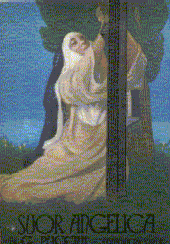|
Suor Angelica
Suor Angelica (Sister Angelica) is an opera in one act by Giacomo Puccini to an original Italian libretto by Giovacchino Forzano. It is the second opera of the trio of operas known as Il trittico (The Triptych). It received its world premiere at the Metropolitan Opera on December 14, 1918.[1] Roles
Synopsis
The opera opens with scenes showing typical aspects of life in the convent. Sister Angelica and two lay sisters - Sister Genovieffa and Sister Dolcina - are late for chapel. All the sisters sing hymns, the Monitor chides Sisters Genovieffa and Dolcina for not doing penance as Sister Angelica has done, and everyone gathers for recreation in the courtyard. The sisters rejoice because, as the mistress of novices explains, this is the first of three evenings that occur each year when the setting sun strikes the fountain so as to turn its water golden. This event causes the sisters to remember Bianca Rosa, a sister who has died. Sister Genovieffa suggests they pour some of the "golden" water onto her tomb.  The nuns discuss their desires for worldly pleasures. While the Monitor believes that any desire at all is wrong, Sister Genovieffa confesses that she longs for the lambs she tended to when she was a shepherdess, and Sister Dolcina for sweet foods to eat. Sister Angelica claims to have no desires, but as soon as she says so, the nuns begin gossiping - Sister Angelica has lied, because her true desire is to hear from her wealthy noble family, whom she has not heard from in seven years. Rumors are that she was sent to the convent as punishment. The conversation is interrupted by the Infirmary Sister, who begs Sister Angelica to make a herbal remedy, her specialty, for a wasp sting. Two tourières arrive, bringing supplies to the convent, and news that a grand coach is waiting outside. Sister Angelica becomes nervous and upset, thinking rightly that someone in her family has come to visit her. The Abbess chastises Sister Angelica for her inappropriate excitement and announces the visitor, the Princess, Sister Angelica's aunt. The Princess rejects Sister Angelica's affectionate gestures. The Princess explains that 20 years prior, she became the guardian to Angelica and her sister Anna Viola when their parents died and that she was given control over her nieces' inheritance. The Princess then reveals her reason for coming to the convent — Angelica must sign a document transferring her inheritance to Anna Viola, who is marrying a man willing to ignore the shame that his fiancée's sister brought on their family. Angelica replies that she has repented of her sin but that she cannot sacrifice everything to the Virgin: she cannot forget the memories of her illegitimate son, who was taken from her 7 years previously and of her aunt's banishing her to the convent as retribution. The Princess at first refuses to respond, but she finally informs Sister Angelica that her son died of fever 2 years previously. Sister Angelica, devastated, signs the document transferring her inheritance and then collapses in tears. The Princess leaves. Sister Angelica is seized by a heavenly vision — she believes she hears her son calling for her to meet him in paradise. She makes a poison and drinks it but realizes that by killing herself she has committed a mortal sin and has damned herself to eternal separation from her son. She begs the Virgin Mary for mercy and, as she dies, she witnesses a miracle: the Virgin Mary appears along with Sister Angelica's son, who runs to embrace her. Recordings
Noted arias
References
Further reading
External links
|
||||||||||||||||||||||||||||||||||||||||||||||||||||||||||||||||||||||||||||||||||||||||||
Portal di Ensiklopedia Dunia

